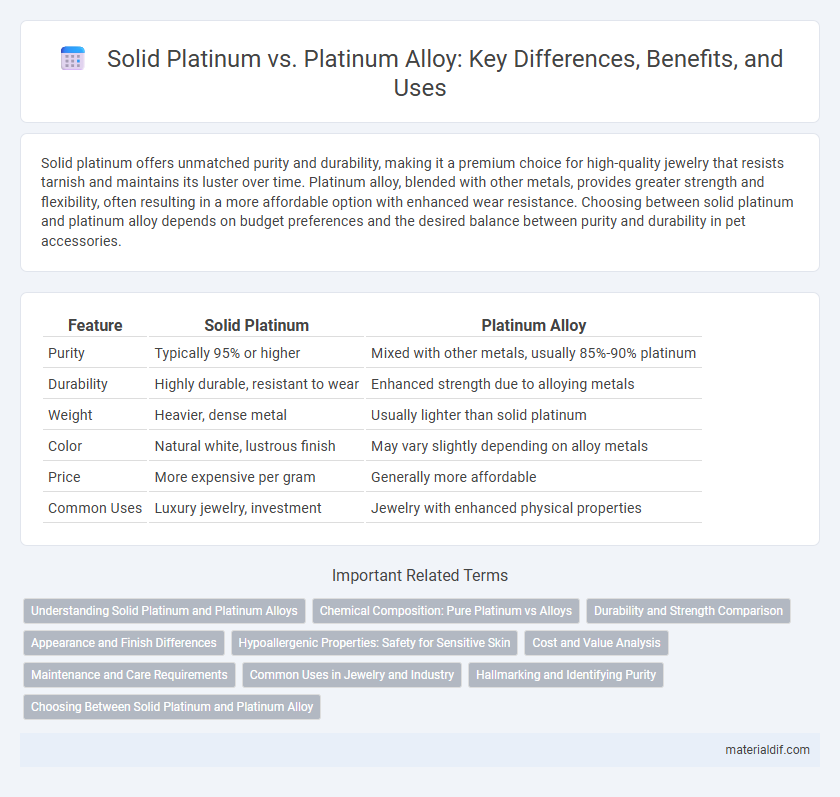Solid platinum offers unmatched purity and durability, making it a premium choice for high-quality jewelry that resists tarnish and maintains its luster over time. Platinum alloy, blended with other metals, provides greater strength and flexibility, often resulting in a more affordable option with enhanced wear resistance. Choosing between solid platinum and platinum alloy depends on budget preferences and the desired balance between purity and durability in pet accessories.
Table of Comparison
| Feature | Solid Platinum | Platinum Alloy |
|---|---|---|
| Purity | Typically 95% or higher | Mixed with other metals, usually 85%-90% platinum |
| Durability | Highly durable, resistant to wear | Enhanced strength due to alloying metals |
| Weight | Heavier, dense metal | Usually lighter than solid platinum |
| Color | Natural white, lustrous finish | May vary slightly depending on alloy metals |
| Price | More expensive per gram | Generally more affordable |
| Common Uses | Luxury jewelry, investment | Jewelry with enhanced physical properties |
Understanding Solid Platinum and Platinum Alloys
Solid platinum consists of nearly 99.95% pure platinum, valued for its exceptional durability, resistance to tarnish, and naturally white luster, making it ideal for high-end jewelry and industrial applications. Platinum alloys combine pure platinum with metals such as palladium, iridium, or copper to enhance hardness and malleability while reducing cost, often used in rings and watches that require both strength and an appealing finish. Understanding the composition and properties of solid platinum versus alloys helps consumers choose between purity and enhanced physical characteristics tailored to specific uses.
Chemical Composition: Pure Platinum vs Alloys
Solid platinum consists of nearly 99.95% pure platinum, providing maximum corrosion resistance and natural white luster, while platinum alloys combine platinum with metals such as ruthenium, iridium, or cobalt to enhance hardness and durability for jewelry and industrial applications. The chemical composition of solid platinum offers superior purity and hypoallergenic properties, whereas alloys adjust the metal's characteristics depending on the secondary elements and their proportions. Understanding the specific mix of metals in platinum alloys is crucial for determining potential variations in color, weight, and strength compared to pure platinum.
Durability and Strength Comparison
Solid platinum offers superior durability and strength compared to platinum alloys, making it highly resistant to scratches, dents, and deformation under stress. Platinum alloys, which contain additional metals such as iridium or ruthenium, enhance hardness but reduce the overall density and weight compared to pure platinum. For long-lasting jewelry or industrial components requiring maximum resilience, solid platinum remains the preferred choice due to its exceptional toughness and natural resistance to wear.
Appearance and Finish Differences
Solid platinum boasts a naturally bright white luster with a smooth, dense surface that maintains its shine over time without the need for plating. Platinum alloys, mixed with metals like iridium or ruthenium, can vary slightly in color and often exhibit a subtly altered hue or finish, depending on the composition. The finish on platinum alloys may require rhodium plating to achieve a uniform brightness, unlike solid platinum which resists tarnishing and dullness.
Hypoallergenic Properties: Safety for Sensitive Skin
Solid platinum offers superior hypoallergenic properties compared to platinum alloys, making it ideal for sensitive skin. Unlike alloys, which may contain metals like nickel that cause allergic reactions, solid platinum is pure and less likely to irritate. This purity ensures maximum safety and comfort for individuals prone to metal allergies.
Cost and Value Analysis
Solid platinum offers superior purity and longevity compared to platinum alloys, making it a premium choice despite its higher initial cost. Platinum alloys, which combine platinum with metals like iridium or ruthenium, reduce costs and improve durability but may compromise some of the metal's natural luster and resistance to tarnish. Evaluating cost versus long-term value, solid platinum retains higher resale value and requires less maintenance, providing greater overall investment security.
Maintenance and Care Requirements
Solid platinum requires minimal maintenance due to its high purity and resistance to tarnish, making it ideal for long-term wear. Platinum alloys, containing additional metals like iridium or ruthenium, may need more frequent cleaning to prevent discoloration or alloy oxidation. Regular polishing and gentle cleaning with mild soap and water help maintain the luster of both solid platinum and platinum alloy jewelry.
Common Uses in Jewelry and Industry
Solid platinum is prized in jewelry for its pure, hypoallergenic properties and durability, making it ideal for engagement rings and fine pieces that require long-lasting shine. Platinum alloys, which combine platinum with metals like iridium or ruthenium, are commonly used in industrial applications such as catalytic converters, electrical contacts, and high-precision laboratory equipment due to enhanced strength and corrosion resistance. While solid platinum jewelry offers unmatched purity and weight, platinum alloys provide versatility and cost-effectiveness in both manufacturing and industrial contexts.
Hallmarking and Identifying Purity
Solid platinum is characterized by a purity of 95% or higher, often indicated by hallmarks such as "950 Pt" or "Plat 950," ensuring guaranteed authenticity and high value. Platinum alloys contain additional metals to enhance durability and are marked with different stamps like "900 Pt" or "850 Pt," representing lower purity levels. Accurate hallmark identification is essential for verifying the precious metal content and distinguishing between solid platinum and its alloys in jewelry and investment pieces.
Choosing Between Solid Platinum and Platinum Alloy
Choosing between solid platinum and platinum alloy depends on durability and price considerations; solid platinum offers exceptional purity (95% or higher) and hypoallergenic properties, while platinum alloys combine platinum with other metals like iridium or ruthenium for enhanced strength and scratch resistance. Jewelry crafted from solid platinum maintains a heavier, denser feel, ideal for investment-grade pieces, whereas platinum alloys achieve a balance of longevity and cost-effectiveness suitable for everyday wear. Understanding the specific karat value and metal composition helps buyers select the optimal option for their lifestyle and budget.
Solid Platinum vs Platinum Alloy Infographic

 materialdif.com
materialdif.com